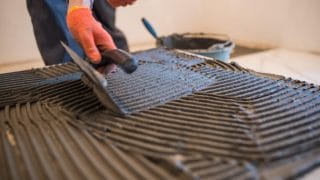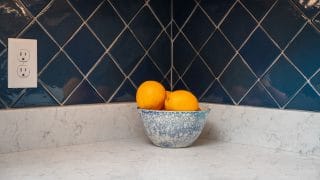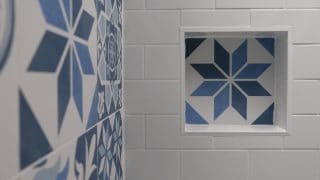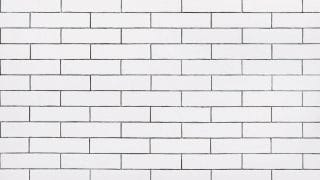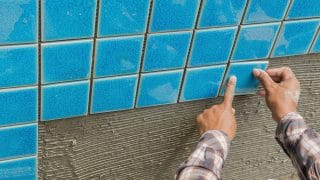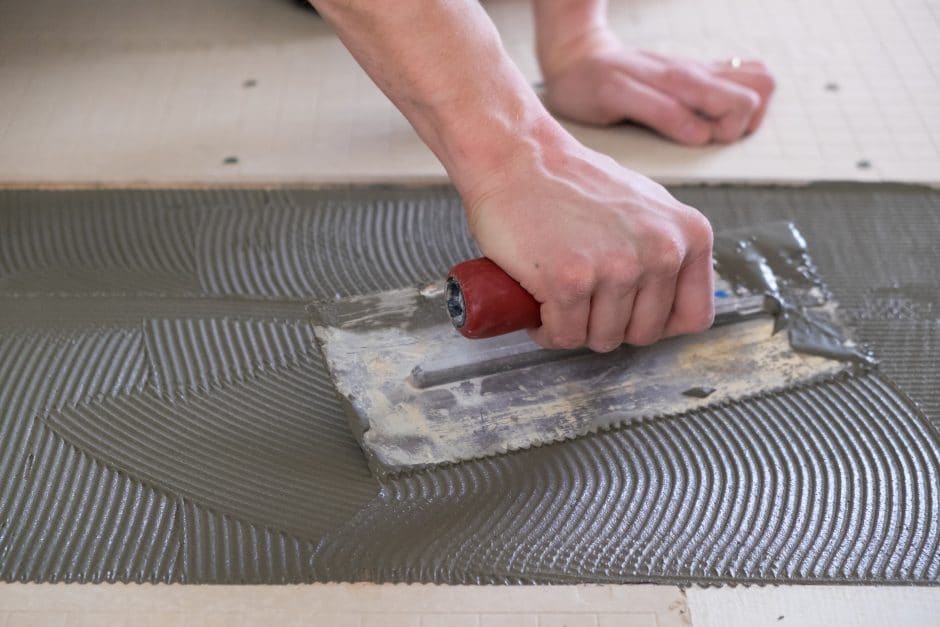
When it comes to glues, adhesives, grouts, and mortars, thinset is a misunderstood material. This adhesive’s properties, abilities, and applications are often confused with those of other mix-and-spread adhesives like mortar or cement, but they’re far from interchangeable.
While thinset is technically a modified mortar, it’s thinner and designed specifically for tiles, unlike mortar which is thick and holds stacked bricks in place. Likewise, thinset contains cement, but its formula lacks the strength to build walls or even serve as a stand-alone flooring product. Thinset’s sole purpose is to hold tiles in place on floors and walls.
What is thinset?
Traditional thinset is a type of mortar made of cement, sand, and water retention agents, and it’s designed specifically for adhering tile to walls. Thinset is widely available at home improvement stores, where it either comes as a dry mix that users can add water to in order to create a spreadable slurry, or in pre-mixed buckets that users can open and spread right away.
Thinset, as the name implies, is thinner than most mortars. This makes it easier to spread across a wide surface while maintaining relative uniformity. Thicker mortars may pile up in certain areas during spreading. However, thinset isn’t so thin that it oozes out through the grout lines, or the spaces between the tiles.
There are two main types of thinset: unmodified and modified. Unmodified refers to thinset in its simplest form: sand, Portland cement, and some water-retaining agents. Modified thinset has acrylic or liquid latex polymers added to the mix to create stronger bonds. In some cases, there may even be chemical-resistant agents added to the mix.
Unlike grout, which is used between tiles, or traditional mortars, which is used between blocks or bricks, thinset should never be visible at the end of the project. It’s used to attach tile or stone to a cement or concrete floor or wall, and it should hide behind the tile. Depending on the size of the space between the tiles, you should use either sanded or unsanded grout.
How is thinset used?
Thinset mortar is an adhesive used for tile installation, adhering these materials to a cementitious substrate. It works on surfaces such as cement, concrete floors, a floor or wall covered in cement backer board, or a waterproof membrane over the top of these materials.
You can use a notched trowel to apply thinset to the floor or walls, or in cases of larger tiles, you should also apply the thinset to the back of the tile. The notched trowel leaves grooves or ridges in the thinset which allows air to escape while the installer lays the tile and presses it into place.
When it comes to glues, adhesives, grouts, and mortars, thinset is a misunderstood material. This adhesive’s properties, abilities, and applications are often confused with those of other mix-and-spread adhesives like mortar or cement, but they’re far from interchangeable.
While thinset is technically a modified mortar, it’s thinner and designed specifically for tiles, unlike mortar which is thick and holds stacked bricks in place. Likewise, thinset contains cement, but its formula lacks the strength to build walls or even serve as a stand-alone flooring product. Thinset’s sole purpose is to hold tiles in place on floors and walls.
What is thinset?
Traditional thinset is a type of mortar made of cement, sand, and water retention agents, and it’s designed specifically for adhering tile to walls. Thinset is widely available at home improvement stores, where it either comes as a dry mix that users can add water to in order to create a spreadable slurry, or in pre-mixed buckets that users can open and spread right away.
Thinset, as the name implies, is thinner than most mortars. This makes it easier to spread across a wide surface while maintaining relative uniformity. Thicker mortars may pile up in certain areas during spreading. However, thinset isn’t so thin that it oozes out through the grout lines, or the spaces between the tiles.
There are two main types of thinset: unmodified and modified. Unmodified refers to thinset in its simplest form: sand, Portland cement, and some water-retaining agents. Modified thinset has acrylic or liquid latex polymers added to the mix to create stronger bonds. In some cases, there may even be chemical-resistant agents added to the mix.
Unlike grout, which is used between tiles, or traditional mortars, which is used between blocks or bricks, thinset should never be visible at the end of the project. It’s used to attach tile or stone to a cement or concrete floor or wall, and it should hide behind the tile. Depending on the size of the space between the tiles, you should use either sanded or unsanded grout.
How is thinset used?
Thinset mortar is an adhesive used for tile installation, adhering these materials to a cementitious substrate. It works on surfaces such as cement, concrete floors, a floor or wall covered in cement backer board, or a waterproof membrane over the top of these materials.
You can use a notched trowel to apply thinset to the floor or walls, or in cases of larger tiles, you should also apply the thinset to the back of the tile. The notched trowel leaves grooves or ridges in the thinset which allows air to escape while the installer lays the tile and presses it into place.
Thinset can be used to adhere tiles of nearly any size and almost any material to walls and floors. Thinset is water-resistant, which makes it suitable for wet locations like showers, bathroom walls, or backsplashes.
Advantages of thinset
There are quite a few reasons why a DIYer might choose to use thinset over another material, such as mastic or even an epoxy adhesive.
- Affordable and widely available. The materials used to make thinset are widely available, such as cement and sand. This makes thinset more affordable than other types of adhesives, especially synthetic materials or glues that use advanced polymers. In smaller spaces such as backsplashes or inlays, the cost might not be a factor. But over a large floor, the cost savings of using thinset over a pre-mixed synthetic adhesive can be significant.
- Evens out the surface. Due to its consistency, thinset can fill some dips or irregularities in a subfloor easily. Thinset easily rolls off the blade of a trowel and into the low spots or dips, creating a more consistent surface than would be possible with glue-based adhesives.
- Takes a long time to set. Thinset has a longer set time than other tile adhesives. While this might seem like a drawback, this actually gives extra working time to spread the mix before it hardens in the bucket. The longer set time gives the user more time to lay and adjust tiles for a perfect installation.
- Water-resistant. Once cured, thinset is more water-resistant than mastic or other tile adhesives. With the right additives, thinset can be chemical-resistant, making it a good choice for commercial or industrial tile applications as well.
Disadvantages of thinset
Thinset is a versatile material, but there are certain instances where it doesn’t make the cut. Here are some of the material’s shortcomings.
- Inflexible. Once dry, thinset has very little flexibility. If the subfloor or substrate isn’t sturdy, any flexing can break the bond between the thinset and the tile. The same applies to wide tiles: if the thinset isn’t evenly spread, stepping on one end of a large tile can cause the far end to pop loose, breaking the bond completely.
- Thinset isn’t visually appealing. Thinset is usually gray and dull, and most folks won’t want to use it behind glass tiles. In these applications, white mastic is typically best as it can highlight the color of the tile without drawing attention to the adhesive behind it.
- Might be too runny. While thinset is useful for walls, unmodified thinset might run too much for vertical tiles. An installer may need to use a modified thinset known as “low slump” or a stickier material like mastic to hold these tiles in place.
MT Copeland offers video-based online classes that give you a foundation in construction fundamentals with real-world applications, like drywall finishing. Classes include professionally produced videos taught by practicing craftspeople, and supplementary downloads like quizzes, blueprints, and other materials to help you master the skills.

